As a recruiter, few things feel better than sourcing a high-quality candidate for your hiring manager. However, it’s difficult (to say the least) to accurately predict which applicants have the abilities to do the job well, will fit into the company culture, and ultimately be able to make an impact on the team.
Unless…you’ve already integrated pre-employment tests into your hiring process or are currently figuring out how to do so. Oh, what is pre-employment skills testing? You’re about to find out!
TL;DR — Key Takeaways
Pre-employment testing offers a standardized, data-backed way to evaluate job applicants’ core competencies, role-specific skills, personality traits, and general cognitive abilities.
Unlike traditional screening methods, standardized tests are scientifically more likely to predict job performance and employee engagement. Skills tests also allow companies to attract applicants from a broader talent pool and prioritize people with the right skills rather than credentials.
Pre-employment tests help recruiters filter candidates who lack the right skills for the role and shortlist the best candidates faster. Other advantages include deeper talent insights, better candidate experience, faster new employee onboarding, and operational cost savings.
Popular types of pre-employment skills tests include technical skills tests, soft skills assessments, cognitive ability tests, competency assessments, emotional intelligence tests, language proficiency tests, and risk tests.
Different types of skills tests serve different purposes in your recruitment cycle. Basic tests help pre-screen candidates, while advanced role-based assignments and personality tests can help with candidate shortlisting and selection.
What is pre-employment testing?
Pre-employment testing (sometimes referred to as a pre-hire assessment) is a standardized measure for evaluating a candidate’s abilities. Pre-employment tests help assess skills, competencies, personality, and other aptitudes to determine their fit for the role.
Unlike resumes and pre-screen interviews, pre-employment assessments offer more objectivity (thanks to comparable scores or consistent rating systems) and promote informed hiring decisions.
In other words: You get to compare people on what they know, rather than how well they market their abilities.
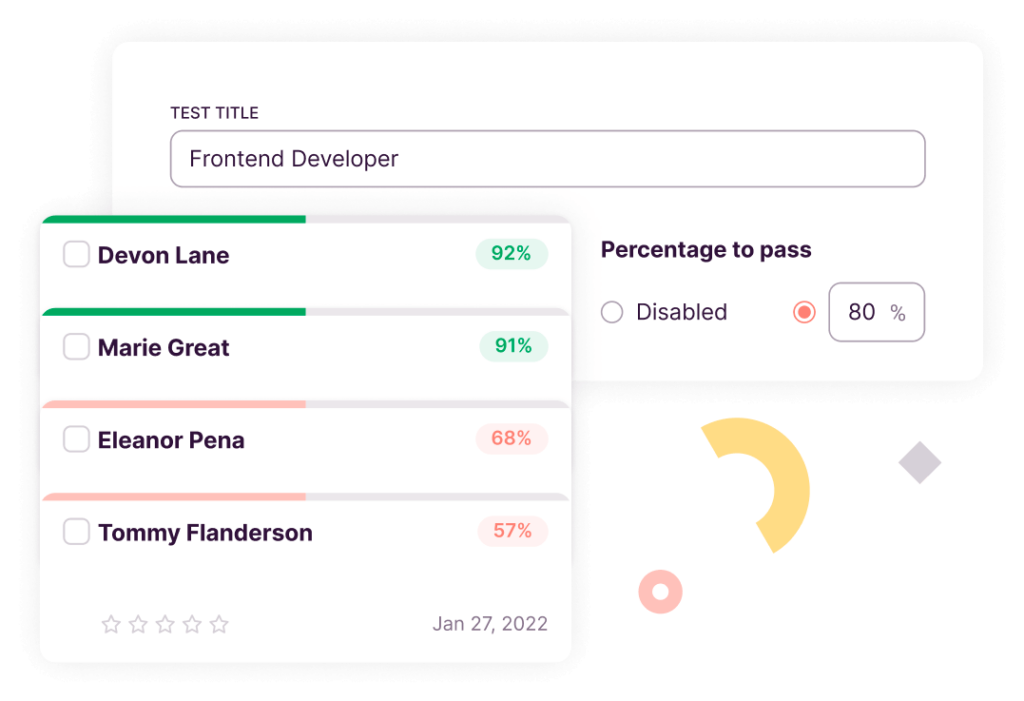
Why pre-employment testing works better than traditional screening methods
Skills-based hiring may sound like a new concept born out of necessity due to the competitive, digital age we live in, but back in the 1980s, researchers were already arguing that “professionally developed cognitive ability tests are valid predictors of performance on the job and in training for all jobs,” based on a backlog analysis of over 50 years worth of employment testing data and several workforce management theories.
Their key finding? Hiring for skills was 5x five more predictive of job performance than hiring for education and more than 2x more predictive than hiring for work experience.
Fast forward to now, and skills-based hiring is among the top recruitment trends. A recent SHRM survey found that 56% of employers use pre-employment tests to evaluate candidates, and one in four plan to use skills assessments more often in the next five years.
What gives? Why such a big shift towards pre-employment testing? There are several reasons, but as the workforce composition changes and more people choose alternative career paths of freelancing and gig work, portfolio careers, or apprenticeship-based programs over traditional education, standard assessment criteria may no longer provide good benchmarks for decision-making during the hiring process.
After all, when you can learn to code via an eLearning platform or master video content creation by being active on TikTok, criteria like “years of experience” or having a “relevant degree” lose their efficacy for pre-screening.
It’s part of the reason why seven in ten US workers believe that employers should hire based on skills, rather than experience — and many companies are following the lead.
The state of Maryland, for example, eliminated degree requirements for almost 50% of positions in healthcare, skilled trades, and engineering to attract more applicants. Walmart plans to remove college degree requirements for a fraction of its corporate jobs, too.
Moreover, skill sets evolve faster than traditional educational programs. Since 2015, the skill sets for jobs have changed by 25%, and that number is expected to double by 2027. Few curriculums also include tutoring on specific project management software or influencer marketing best practices — these are skills people learn on the job.
The bottom line? Pre-employment tests help effectively identify people with the right skill sets, competencies, and character traits rather than impressive educational credentials, inflated accomplishments, or fake job experience on a resume.
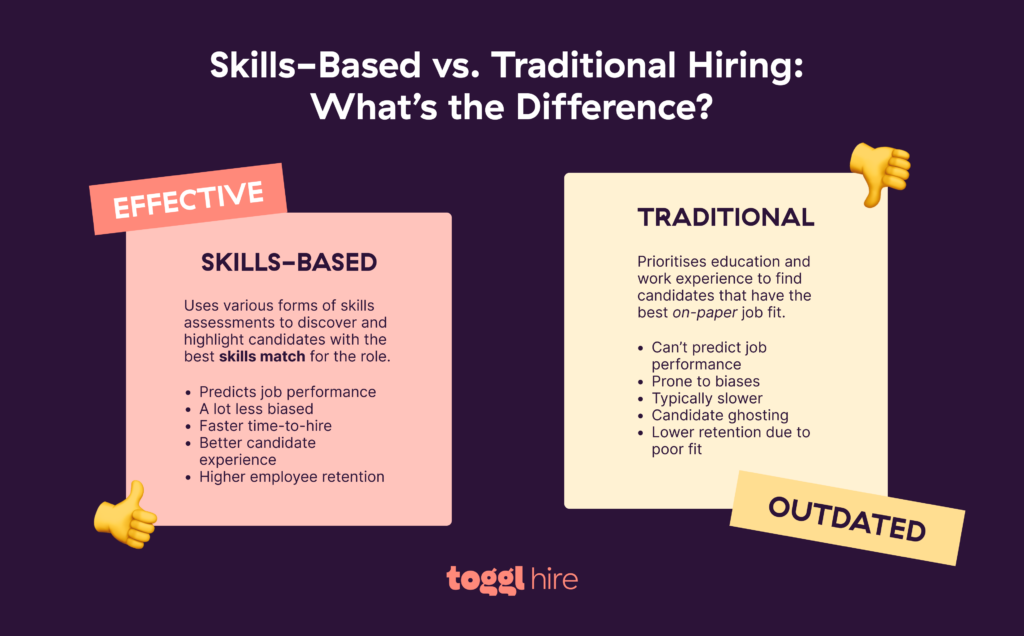
How we use pre-employment skills assessments to hire top talent
We don’t believe in pre-employment skills tests because they’re the “cool” thing in hiring. We believe in them because they work.
At Toggl, our parent company that includes Toggl Track, Toggl Plan, Toggl Work, and, of course, Toggl Hire (hey, that’s us!), we rely on a combination of short multi-question skills assessment tests and open-ended homework assignments to pre-screen and shortlist job candidates.
Across all Toggl products and teams, our standard hiring process goes like this:
Screening job knowledge test: Using pre-made questions from our test library, our hiring managers can create competency-based tests in 15 minutes or less to quickly pre-assess any number of applicants.
Cultural interview: Everyone who scored above the testing threshold gets invited to a culture-fit interview. Since we’re a mission-driven remote company, we want to hire people with similar values, working styles, and collaboration preferences.
Homework assignment: Once the technical and cultural fit is confirmed, the shortlisted candidates will move on to a longer homework assignment. Modeling a real-life job task, such standardized assessments help us evaluate the candidates’ practical knowledge and predict job performance.
Depending on the role, we may also opt to do asynchronous video interviews to screen for soft skills, such as critical thinking and communication, early on. Most of our roles also include a paid test day (or even a whole week), offering a realistic job preview where candidates interact with the team and show their chops in the field.
By structuring our recruitment process around pre-employment assessments, our hiring managers spend 22 hours less on sourcing, screening, and shortlisting job applicants. We’ve hired over 150 new employees with a skills-based approach, and now help others do the same. By implementing similar practices, other companies screen candidates 80% faster and reduce time-to-hire for new tech roles by 85%.
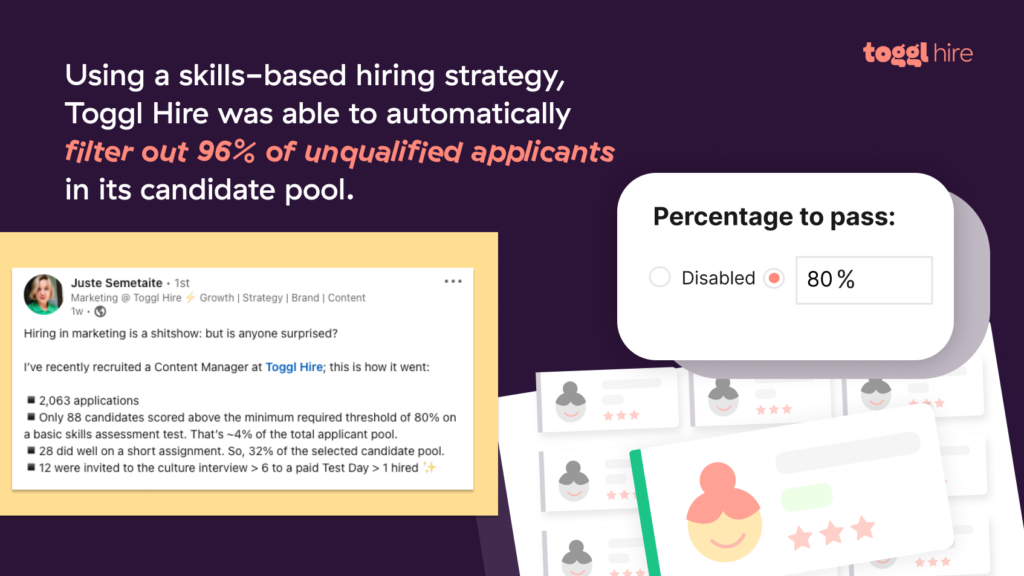
What are the advantages of pre-employment testing?
Pre-employment tests are a low-effort, high-impact action that boosts recruiting metrics like the number of applicants, qualified candidate rate, time-to-hire, plus candidate experience scores. Other benefits include the following.
Data-driven hiring decisions
With pre-employment skills testing, it’s much easier to gather objective data on candidates’ skill sets, personality traits, and cognitive abilities. With the right tool, you can automatically filter out the applicants who lack technical knowledge and move the best candidates faster through your hiring process. Pre-employment testing also helps reduce hiring bias and promotes fair hiring practices.
Extra talent insights
Skills tests help you see more sides of the candidate, a bit like a 2D image vs. a 3D model. You get a better idea of how the candidate’s experience and skills match up to the job description and whether their personal characteristics fit with your company. Internally, they can also help you measure emerging skills gaps and the general talent market dynamics.
Better candidate interviews
Use data from a pre-employment assessment to guide your selection of job interview questions. For example, you can focus more on evaluating the applicants’ critical thinking abilities and situational behaviors, rather than probing their job knowledge, to learn more about their behavioral traits, management styles, and interpersonal skills.
Cost savings
Reduce the cost of bad hires and high turnover costs by increasing the likelihood of both a good fit and stronger job performance with job knowledge tests. You can also save time (and money) for the entire hiring team by reducing the time spent on resume reviews and endless job interviews.
Better employee onboarding
Use data from pre-employment tests to create an onboarding plan or career development plan for new hires. Help new hires be more productive faster by helping them develop the right skills needed to succeed in their role. For example, instead of shoehorning all new IT hires to complete cybersecurity training, allow candidates with strong skills to skip it to learn more about your CI/CD pipeline design.
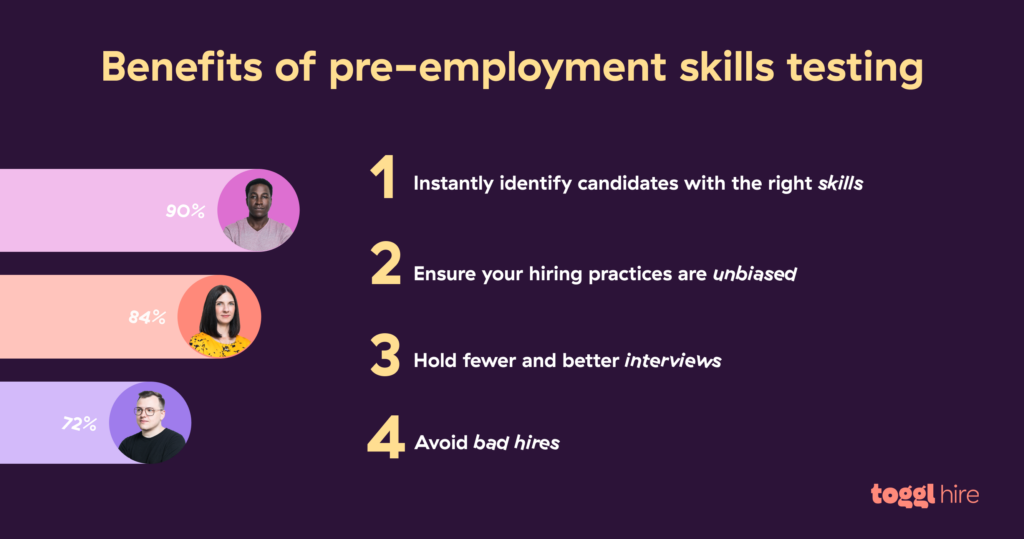
What about the disadvantages of pre-employment testing?
Few things in life don’t have a flip side (except for chocolate chip cookies, maybe, because the flip side of cookies is still delicious). So, although applicant testing provides hiring teams with ample data for decision-making, it can also have some downsides.
Risk of a higher candidate drop-off
Some candidates may find standard pre-employment tests off-putting (especially if they’ve applied for similar roles and have had poor experiences with clunky tests).
To encourage more job applications, start with a shorter pre-employment screening assessment. Time it to 15 to 30 minutes and state the duration upfront. Test primarily for hard skills and leave other types of assessments (e.g., an integrity test or personality test) for a later stage.
The cost of administering pre-employment tests
Pre-employment tests may seem like yet another overhead cost, sure. But the real question is…can your team afford to keep wading through endless resume piles, dealing with interview scheduling conflicts, and ultimately — the cost of a bad hire?
When we spoke to Dunja Lazic, VP of Marketing at Sked Social, she recounted when her team had to review 200 resumes and schedule over 15 screening interviews. They felt absolutely burned out by the final interview round. With Toggl Hire’s pre-employment tests, they can now screen 800 applicants in one hour, identify the best hires, and hire for new roles twice as fast!
Candidate cheating on skills assessment tests
“But aren’t people going to ask someone else to complete pre-hire assessments or use ChatGPT?” Well, some will try. However, modern skill assessment platforms are ahead of the game and can quickly flag their behavior, saving you from a potential mis-hire.

Toggl Hire, for example, offers various anti-cheating measures to help ensure reliable assessment results. Flag candidates for suspicious behavior that includes:
Completing several tests from the same browse
Copying and pasting the test questions
Detecting how likely it is that a test answer was generated using AI
The likelihood of cheating depends on the test you offer candidates, too. For example, popular personality questionnaires have dubitable accuracy since candidates can easily choose more favorable character traits. Soft skills assessments or situational judgment tests, on the other hand, can help evaluate how a person thinks, acts, and behaves in different situations.
7 common types of pre-employment tests
Ready to incorporate more data into your hiring decisions? Here are the seven common pre-employment test types we recommend using:
✅ Technical skills tests
✅ Soft skills assessments
✅ Cognitive ability tests
✅ Language proficiency tests
✅ Competency assessments
✅ Emotional intelligence tests
✅ Risk tests
Here’s how each one can improve your hiring process.
1. Technical skills tests
Most employers use pre-employment testing to screen for technical skills. After all, you want people who can perform their job in real life, not just on their resume.
Technical skills assessments evaluate the candidate’s knowledge and expertise in their domain. For example, you may test a software engineer’s knowledge of Java, Python, Ruby, or another programming language. Or, you might evaluate a broader technical skill set, like those required for an SEO manager or Growth Marketer role.
2. Soft skills assessments
Soft skills (or power skills as we call them) are as important as strong technical skills. Teaching a person a new technical method or project management workflow is way easier than fixing their (lack of) personal accountability or a natural tendency for non-constructive criticism.
Soft skills assessments (sometimes called personality tests in the hiring world, although personality tests are technically a subcategory) help determine if the candidate’s personality or behavioral tendencies fit well for a particular role, and with the company culture.
By asking situational, behavioral, and role-play-styled questions in an online test you can quantitatively evaluate applicants’ communication, problem-solving, time management, and remote work skills among others. Combine test data with real-world feedback from culture-fit interviews to get the most suitable candidates on board!
View a sample soft skills assessment from Toggl Hire 👉 Teamwork Skills Test
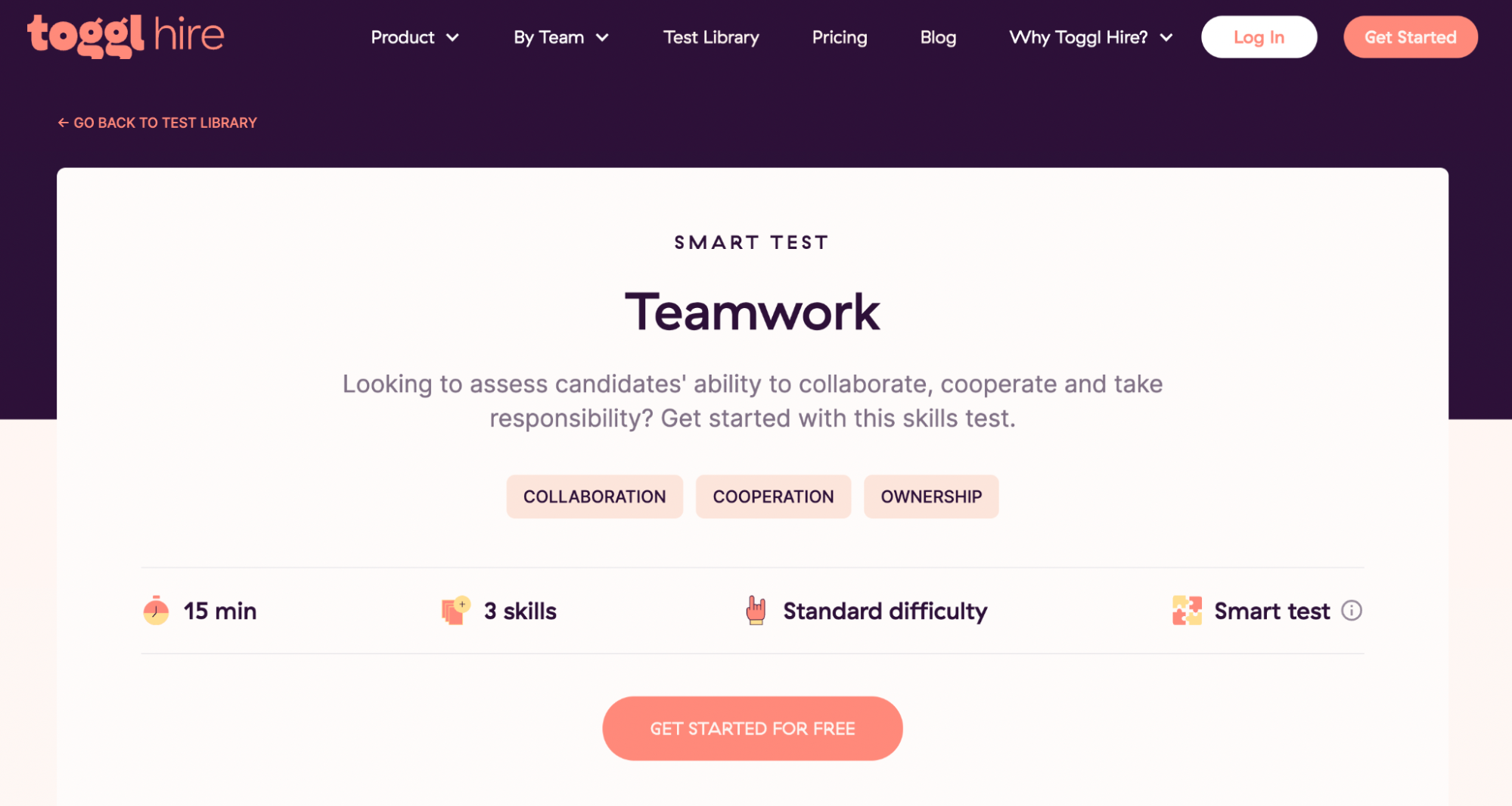
3. Cognitive ability and aptitude tests
Cognitive ability tests (also called simply aptitude or IQ tests) measure a person’s ability to think, learn, reason, and apply information. These tests can measure specific abilities like:
Critical thinking
Numerical reasoning
Verbal reasoning
Logical reasoning
Mechanical reasoning
Aptitude tests help recruiters learn more about a candidate’s strengths and weaknesses and are often used in screening for mid to senior-level roles. These tests could be particularly helpful for technical roles like engineers or in roles where high-level problem solving is needed, like a project manager.
4. Language proficiency tests
As work goes global, you may be hiring remote team members internationally or looking for multi-language candidates to support your expansion to a new market. If you’re hiring for roles that require native-level fluency in one language, plus good English language skills, use a simple, standardized language test.
Language assessments evaluate a candidate’s spoken and written proficiency in a second (or third, or fourth!) language. If you require flawless communication language skills for roles like tutors, pre-screen candidates using internationally recognized certificates like CELTA, TEFL, or TESOL for English language or DALF for French.
5. Competency assessments
Competency assessments measure a person’s skills, experience, and specific competencies against job requirements. They are role-specific, which is why you might see them called job knowledge tests, and help benchmark the candidate’s potential against the set hiring criteria.
For example, if you’re hiring an Account Executive, a competency skills assessment would include questions about their knowledge of the sales cycle, customer relationship management skills, and experience with specific markets and/or nurturing techniques.
Examples of competency assessments include:
Role-based tests: Based on the job analysis, determine the key functional competencies for the role. Use Toggl Hire’s test database to build customized competency tests for different roles. Our questions draw on expert knowledge and cover a wide range of roles — from accounting to sales and support.
Interview-based assessment: Competency-based interviews include standardized questions for each applicant, designed to assess their core competencies, like critical thinking or analytical skills, and specific hard skills, like data analytics skills. A hiring manager then receives a scorecard and a candidate evaluation form with fleshed-out assessment criteria and ratings.
Homework tasks: To assess the candidate’s skills in context, you can give out longer take-home assignments — a coding challenge, a client case study, a presentation demo, or any other well-scoped task. Toggl Hire provides over 500 ready-made homework templates with in-built assessment criteria to test a wide range of competencies.
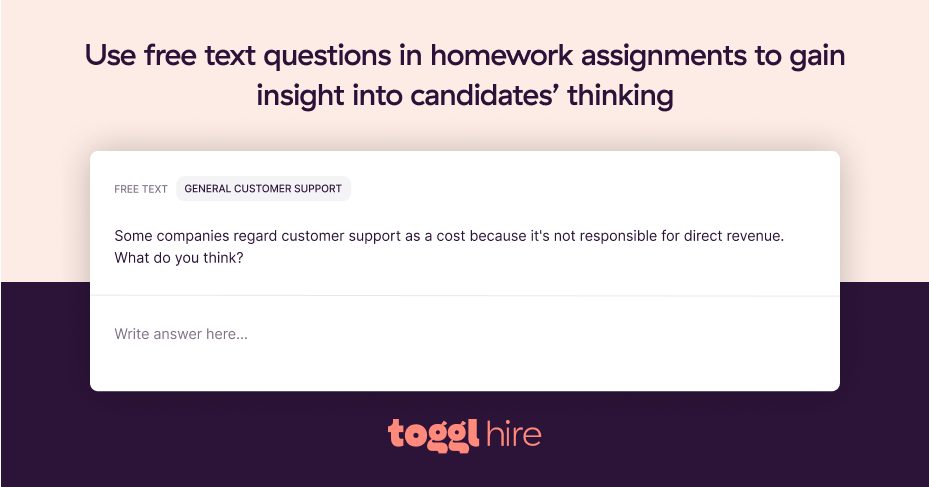
6. Emotional intelligence tests
An emotional intelligence test is a good add-on to a general soft skills assessment if hiring for managerial, executive, or senior customer-facing roles.
Emotional Intelligence is commonly defined by four attributes: Self-management, self-awareness, social awareness, and relationship management.
Marc Brackett, Ph.D., founding director of the Yale Center for Emotional Intelligence
Test takers with a high EQ may have the same skills and job knowledge, but they’re also more likely to navigate the social complexities of the workplace better, show strong leadership qualities, and communicate effectively with diverse groups.
7. Risk tests
Some employers use pre-employment tests to weed out candidates who may not meet workplace safety criteria. These are risk assessments, and they help reduce the likelihood of poor workplace behavior that could endanger other employees’ safety and corporate operations.
There are a few types of risk tests:
Integrity tests evaluate how likely a candidate is to follow the company’s rules and root out any counterproductive tendencies, like absenteeism or safety violations. Integrity tests are often used for entry-level positions to ensure potential employees will take responsibility for completing their tasks efficiently.
Safety assessments look at how likely a candidate will behave in a way that creates or heightens the risk for themselves or their coworkers. While this isn’t a personality test, the test results of a safety assessment are crucial to the hiring decision for high-risk workplaces.
Physical ability tests determine if a person meets the physical requirements of a job. While not always relevant, especially as more companies go remote, physical ability tests are relevant for very physical work like jobs in construction or firefighting.
Background checks are a type of risk test, but they can be very costly to implement in the hiring process. Luckily, integrity tests can be an even more effective solution as they often uncover a broader range of unproductive or unethical behaviors.
How to decide which type of pre-employment assessments to use
Pre-employment assessment tests work best when you use a combination of them. Combine role-based aptitude tests with more specific questions about the candidate’s numerical reasoning, problem-solving, or good critical-thinking skills, for example.
Ultimately, your choice of tests will depend on the ideal candidate profile you’ve created for the job description and role you’re hiring for. General cognitive ability may be key for an entry-level role, while specific skills in marketing, sales, or engineering are essential for others.
Here are a few things to consider as you compare common pre-employment tests:
- Role Seniority: Junior roles attract more applicants, meaning you’ll want to pre-screen candidates fast for basic proficiencies. Senior roles require more prolific skills, stronger situational judgment, and high emotional intelligence, especially for managerial positions.
- Job Requirements: Match skills tests to the required core competencies and knowledge of specific tools, processes, and technologies.
- Test Duration: Vary the test length to avoid candidate fatigue and high drop-off rates. Limit pre-screen test duration to 30 minutes (or less) and open-ended assignments to one hour.
- Scientific Validity: Avoid using tests with questionable research validity (especially personality tests), as these further perpetuate hiring bias.
- Degree of Customization: To get better results, use customizable pre-assessments, rather than a general aptitude test or broad cognitive assessments. Unless you’re hiring strong generalists, create questions to test role-specific skills and competencies.
- Feedback Mechanism: Choose pre-employment screening tests that provide instant feedback to elevate the candidate experience. For example, 4 out of 5 applicants love Toggl Hire for immediate scores and quick updates on their application status.
- Hiring Laws and Regulations: All administered pre-employment tests must comply with anti-discrimination guidelines. Ensure the tests don’t disadvantage any group and that they promote a diverse and inclusive workplace.
Example of implementing pre-hire assessments
Let’s say you’re just starting the hiring process for a junior UI developer and a senior full-stack developer.
For the junior role, a good mix of tests could include a programming skills test (adjusted to their level of knowledge) with some probing questions about their general mental ability. Give candidates with good potential a fair shot.
Starting with a basic, short technical skills assessment can help you whittle down the applicant pool quickly. Then, invite the best candidates to do a structured interview (to check their communication and problem-solving skills) and consider doing extra interviews if you still have doubts.
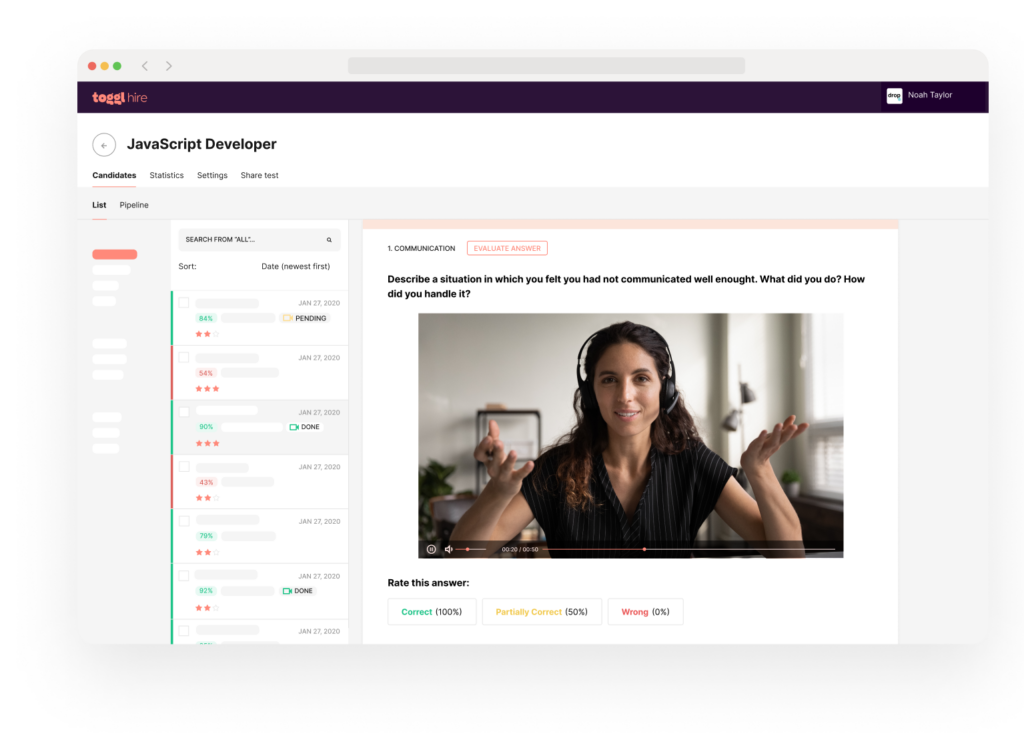
For the senior role, you’ll want to drill down further into the candidate’s skills from the start. Combine a basic pre-employment test with an open-ended coding assignment to evaluate a broader scope of skills.
Next, you could add an asynchronous video interview — a pre-recorded video Q&A that candidates create, sharing more info about their skills, experiences, and knowledge. Video interviews are a great way to screen candidates for initial culture fit and emotional intelligence.
If the senior role assumes managerial duties, add a behavioral interview to evaluate the candidates’ situational judgment, communication skills, and overall people management skills.
Where do pre-employment assessments fit in the recruitment process?
As you’ve learned by now, skills assessments have many use cases. But too much choice often breeds confusion. To avoid alienating candidates with multiple tests (and making your job harder than it should be), here’s how to slot pre-employment tests into your hiring process.
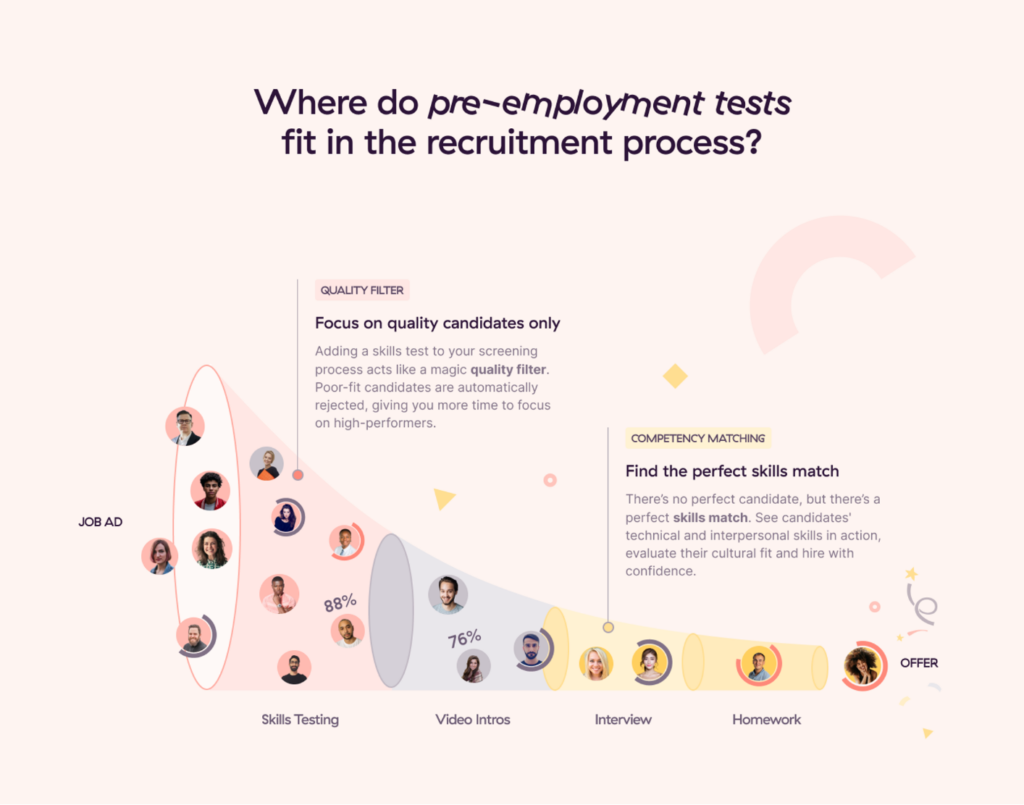
Candidate screening
Identify qualified candidates faster at the beginning of the hiring process through short, standardized tests designed to evaluate the applicants’ core competencies and aptitude for the role.
Examples of candidate screening tests: Cognitive ability tests, role-based job knowledge tests, language proficiency pre-employment assessments, and technical skill assessments
Candidate shortlisting
Use a combination of open-ended assignments and structured interviews to get extra data for decision-making. Reduce bias by focusing on candidates’ abilities and character values, which predict future job performance.
Examples of shortlisting tests: Soft skills and personality assessments, homework assignments, and async video interviews.
Candidate selection
Get the final proof of “fit” and competency by evaluating the candidates’ skills in action with job simulations that represent real-world tasks and challenges in their new role.
Examples of candidate selection methods: Culture fit interview, live exercise, role-play, and paid test days.
Try a pre-employment assessment with Toggl Hire
Pre-employment testing is a much more modern, fair, efficient, and engaging way to screen candidates for qualifications. Skills tests specifically up the recruitment process and enable data-driven hiring and smarter HR decisions.
With Toggl Hire, you’ve got hundreds of pre-employment tests available to help you evaluate candidates’ cognitive abilities, core competencies, job knowledge, interpersonal skills, emotional intelligence, language proficiency, and many other skills at every stage of your recruitment process.
Don’t just take our word for it, though. See why we love pre-employing skills testing and create a sample assessment using questions from our skills test library! It’s free…so you have no reason not to. 👀
Elena is a freelance writer, producing journalist-style content that doesn’t leave the reader asking “so what." From the future of work to the latest technology trends, she loves exploring new subjects to produce compelling and culturally relevant narratives for brands. In her corporate life, Elena successfully managed remote freelance teams and coached junior marketers.










